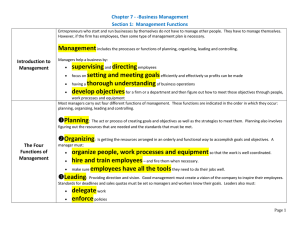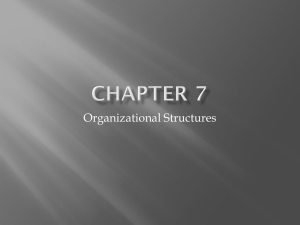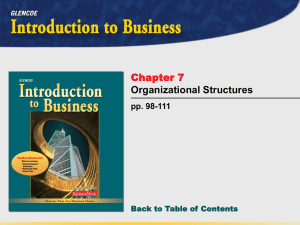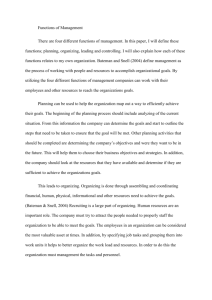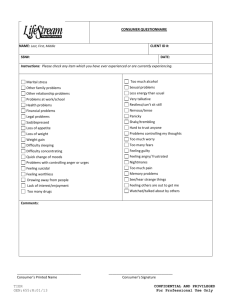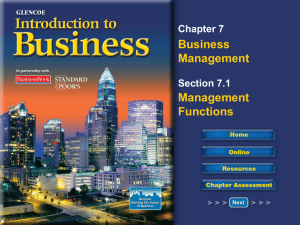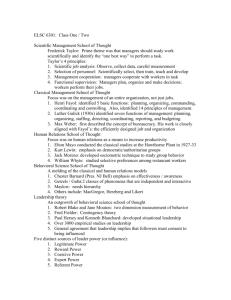Business Management Functions & Structures
advertisement
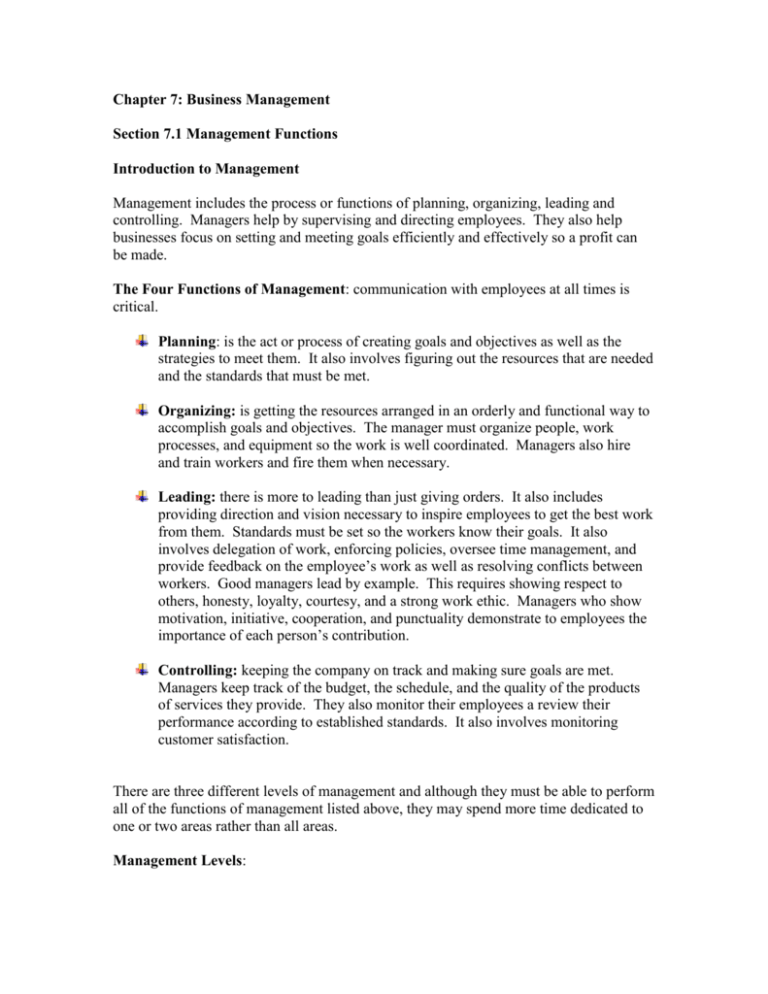
Chapter 7: Business Management Section 7.1 Management Functions Introduction to Management Management includes the process or functions of planning, organizing, leading and controlling. Managers help by supervising and directing employees. They also help businesses focus on setting and meeting goals efficiently and effectively so a profit can be made. The Four Functions of Management: communication with employees at all times is critical. Planning: is the act or process of creating goals and objectives as well as the strategies to meet them. It also involves figuring out the resources that are needed and the standards that must be met. Organizing: is getting the resources arranged in an orderly and functional way to accomplish goals and objectives. The manager must organize people, work processes, and equipment so the work is well coordinated. Managers also hire and train workers and fire them when necessary. Leading: there is more to leading than just giving orders. It also includes providing direction and vision necessary to inspire employees to get the best work from them. Standards must be set so the workers know their goals. It also involves delegation of work, enforcing policies, oversee time management, and provide feedback on the employee’s work as well as resolving conflicts between workers. Good managers lead by example. This requires showing respect to others, honesty, loyalty, courtesy, and a strong work ethic. Managers who show motivation, initiative, cooperation, and punctuality demonstrate to employees the importance of each person’s contribution. Controlling: keeping the company on track and making sure goals are met. Managers keep track of the budget, the schedule, and the quality of the products of services they provide. They also monitor their employees a review their performance according to established standards. It also involves monitoring customer satisfaction. There are three different levels of management and although they must be able to perform all of the functions of management listed above, they may spend more time dedicated to one or two areas rather than all areas. Management Levels: Top-level manager: responsible for setting the goals of the company, planning for the future as well as leading and controlling the work of other managers. Some titles of this level of management include the chief executive officer (CEO), president, and vice president. Middle manager: carries out the directives of top-level management. Their job entails mostly organizing function as well as leading and controlling the work of others. Although some planning is required they mostly carry out the planning of top-level management. Operational manager: is responsible for the daily operation of the business. Some titles of this level of management include supervisors, office managers, and crew leaders. Their main duties include overseeing the workers and meeting deadlines (leading and controlling). Reading Check p. 114 After You Read p. 114 Section 7.2 Management Structures Managerial Structures: Line authority is a structure in which managers on one level are in charge of those beneath them. One advantage is that authority is clearly defined. Each employee knows to whom she or he reports. A disadvantage is that the managers have few specialists who help with their responsibilities. (Figure 7.2, p.116) Centralized Organization: all authority is in one place, top-level management. Usually associated with smaller domestic businesses. Decentralized Organization: gives authority to a number of different managers. Usually associated with large international businesses. Formal Structure: Departmentalization divides responsibilities among specific units or departments. Departments are usually organized by geography, function, customer groups, and product. Usually found in larger businesses. Informal Structure: Very flexible with responsibilities changing from time to time depending on the need. Usually found in smaller businesses. Is a Manager’s Job for You???????????????????????? Most managers begin their careers in an entry-level position and work their way up into management via promotions. Skills Needed by Managers: Must be task-oriented and able to handle many different tasks at the same time. Must be able to organize your time and decide which tasks take precedent. Must keep accurate records and have an attention to detail. Must be able to work well under pressure. Must have good problem solving skills. Must have good communication skills including listening (written, oral, and body language) Must have good human relation skills. Must have some knowledge of the technical aspects of their business. Advantages of Being a Manager Earn more money Get to lead people which can lead to respect of other people Prestige Influence Greater control over their time Disadvantages of Being a Manager You get the blame Mistakes can be very costly Always working under pressure After You Read p.119

